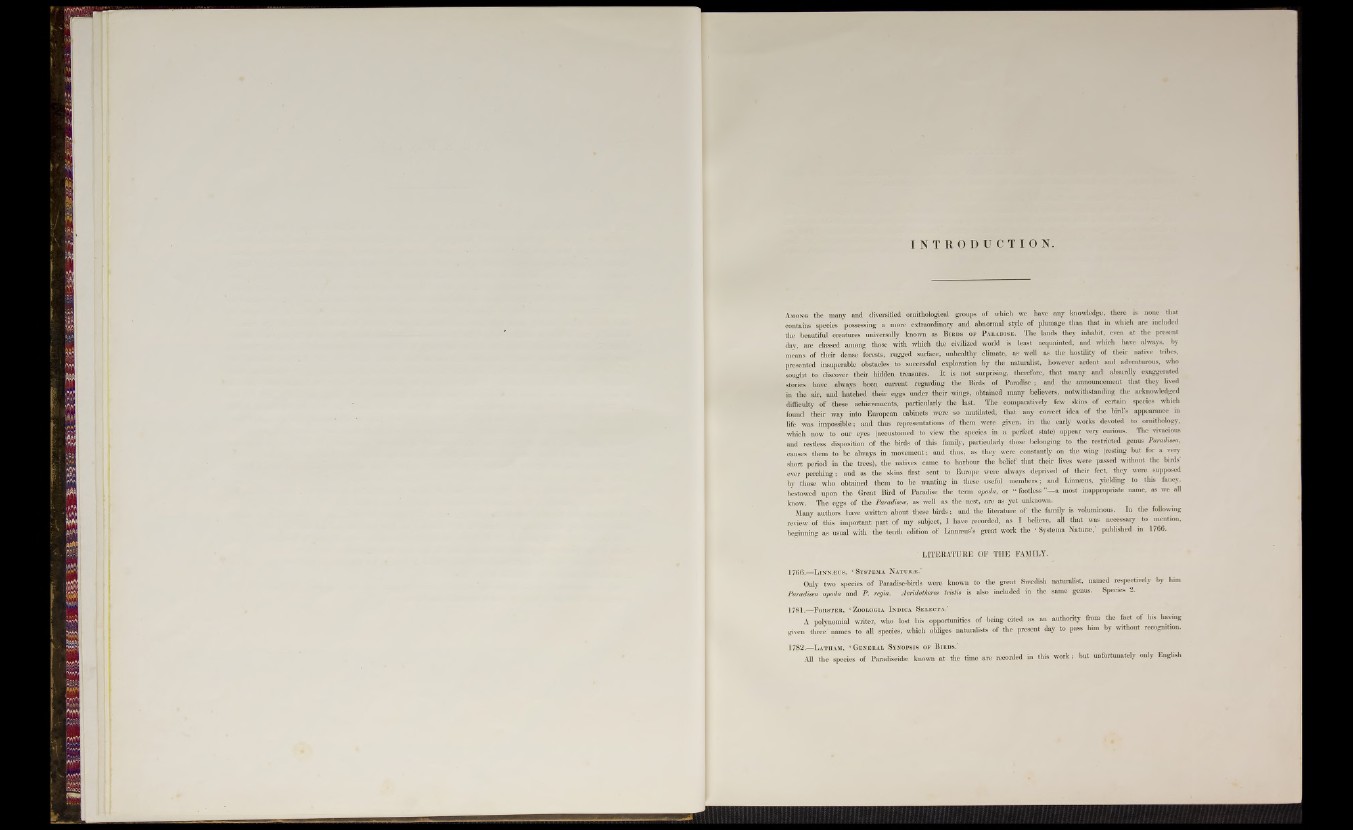
I N T R O D U C T I O N .
A m o n g the many and diversified ornithological groups of which we have any knowledge, there is none that
contains species possessing a more extraordinary and abnormal style of plumage than that in which are included
the b e autiful creatures universally known as ■Bir d s o f P a r a d i s e . The lands they inhabit, even at the present
day, are classed among those with which the civilized world is least acquainted, and which have always, by
means of their dense forests, rugged surface, unhealthy climate, as well as the hostility of their native tribes,
presented insuperable obstacles to successful exploration by the naturalist, however ardent and adventurous, who
sought to discover their hidden treasures. I t is not surprising, therefore, that many and absurdly exaggerated
stories have always been current regarding the Birds of Paradise ; and the announcement that they lived
in the air, and hatched their eggs under their wings, obtained many believers, notwithstanding the acknowledged
difficulty of these achievements, particularly the last. The comparatively few skins of certain species which
found their way into European cabinets were so mutilated, that any correct idea of the bird’s appearance in
life was impossible; and thus representations of them were given, in the early works devoted to ornithology,
which now to our eyes (accustomed to view the species in a perfect state) appear very curious. The vivacious
and restless disposition of the birds of this family, particularly those belonging to the restricted genus Paradwea,
causes them to be always in movement; and thus, as they were constantly on the wing (resting but for a very
short period in the trees), the natives came to harbour the belief that their lives were passed without the birds’
ever perching; and as the skins first sent to Europe were always deprived of their feet, they were supposed
by those who obtained them to be wanting in these useful members; and Linnaeus, yielding to this fancy,
bestowed upon the Great Bird of Paradise the term apoda, o r f o o t le s s a most inappropriate name, as we all
know. The eggs of the ParadisetB, as well as the nest, are as yet unknown.
Many authors have written about these birds; and the literature of the family is voluminous. In the following
review of this important part of my subject, I have recorded, as I believe, all that was necessary to mention,
beginning as usual with the tenth edition of Lmnteus’s great work the ‘ Systema Naturae,’ published in 1766.
LITERATURE OF THE FAMILY.
1766.—L i n n .®u s , ‘ S y s t em a N aturae. ’
Only two species of Paradise-birds were known to the great Swedish naturalist, named respectively by him
Paradwa apoda and P. regia. Acndotheree truth is also included in the same genus. Species 2,
1781.—F o r s t e r , ‘ Zo ologia I n d ic a S e l e c t a .’
A polynomial writer, who lost his opportunities of being cited as an authority from the fact of his having
given three- names to all species, which obliges naturalists of the present day to pass him by without recognition.
1782.—L a t h a m , ‘ G e n e r a l S y n o p s i s o f B ir d s .'
' All the species of Paradiseidas known at the time are tecotded in this work; but unfortunately only English